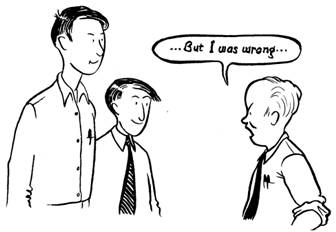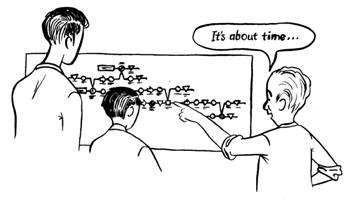
Insanity – Bureaucracy,
What’s the Difference?
By Dr. Ben S. Graham, Jr.Chairman
The Ben Graham Corporation
© Copyright 2006, The Ben Graham Corporation. All rights reserved.
Links may be established to this paper.
When an individual consistently behaves in a way that is clearly out of touch with reality, we describe that person as being; not of sound mind, mentally deranged, insane. But when an organization consistently establishes work processes that are out of touch with reality, we don’t call the organization insane. We call it bureaucratic and put up with it as if it were a necessary evil of organizational life. It is not.
.jpg)
The principal cause of bureaucracy is that rules of work (which must be followed whether they make sense or not) are developed at a distance from reality. And, the primary reason for this distance is that work processes are interdepartmental. They flow through departmental boundaries with ease. Therefore, to find a person with enough authority to revise a process means moving up in the hierarchy several levels away from the work. The people who are closest to the work and have the best handle on the reality of the work can only make limited fixes to the work. Desk tidying they can do, but anything that would have an impact beyond their work area is outside of their authority.
Of course many changes are made to processes within operating level work units. When they are made, care is usually taken to make sure that the work leaves the area in the same format that it has been so that it will not cause problems in the next work area that receives it. Often this means retranscribing some of the data or maintaining double records. As these local changes accumulate, a process becomes increasingly cumbersome and subject to breakdown.
Occasionally, concern for a process reaches the level of the organization where authority spans the entire process. This concern may occur because the process has broken down, or it may occur because of some major change in the organization, or a change in senior officers. It could be something as simple as a senior officer being sold on something he saw at an equipment show, heard about from a consultant or read about in a business magazine. It doesn’t matter what raised this concern, the key issue is that the concern is at a distance from the reality of the work, the reality that is known only to the people doing the work. But it is at this senior level where we find the authority to change the work of an interdepartmental process.
Now, it would make perfectly good sense for the senior people, when they are concerned enough to repair or replace a process, to seek advice from the people who know the most about that process. But do they? Traditionally not, for various reasons. For instance...

- Senior managers fear that the operating people will be defensive and want to keep doing the work the way they have been doing it. In my 45 years of working with veteran employees, I have not found this to be true. In fact, I have often heard complaints like this. “The last time they revised this process, I thought they got it about as bad as they could…but I was wrong. Look at what they have done this time.”
- Senior managers may feel that the people doing the work are the ones who messed up the process in the first place and therefore it just doesn’t make sense to go to them to fix it. There may be some truth here to the extent that the operating people have injected limited fixes into the process that have made it more cumbersome and vulnerable. However, this is because of their limited authority. The senior manager can change that. He or she has authority that spans the process and could use that authority to form a team of operating people whose collective experience also spans the process.
- Sometimes senior managers want to keep a process renovation project a secret to prevent employees from worrying about changes that might affect their jobs. Often, but not always, these managers have every intention of making sure that their employees will be well taken care of - that is not laid off. In fact, word of these secret projects almost always gets out and the concern of the workers is far greater when they get wind of this project than it would be if it were presented openly. This type of activity sometimes backfires as some of the best employees (those who would have the least difficulty finding another job) see the writing on the wall and leave. Secret projects, in this way serve to purge an organization of outstanding employees.
- Senior managers may get caught up in the excitement of some new technology that they have heard about. This is something they will bring into their organization and naturally they have to go outside the organization to get it. There is nothing wrong with going outside the organization. In fact ideas and concepts for a new process can come from anywhere. But, they should never be injected into an organization without a reality check. The process should be studied and revised by the operating people and when it takes technical knowledge that they don’t have, this calls for adding another person to the team, not turning the project over to them.
- Another thought that can prevent senior managers from turning to their operating people is a stigma attached to the idea of a homemade solution. Clichés like ‘you get what you pay for’ can lead to spending a great deal of money to get a process that is not nearly as good as what the employees would have come up with. And, after a great deal of money has been spent on a poor solution there is a tendency to want to force it to work.
- Of course, sometimes the intention of senior management is to downsize and they can hardly expect their employees to use their ingenuity and experience to work out a new process that gets them a pink slip. There are many drawbacks to using process improvement to downsize and perhaps the worst of these is that it firmly links process improvement and job loss in the minds of the work force, which creates a formidable impediment to future improvement. Process improvement should be done to make processes better; faster, more accurate, more complete, easier to work with, etc. When this results in needing fewer employees, those senior officers who realize that the continuing loyalty and trust of their employees is vital to their long term success choose to earn that loyalty and trust. They come up with innovative ways of avoiding layoffs by using attrition, transfer, spawning new businesses, expanding the current one, etc.
- Another twist on downsizing I have run into is where senior managers get some of their employees aside and let them know that there will be a reduction in staff but assure them that they will not be among those dismissed. This has been used as an approach to getting employee involvement while downsizing. I suppose there are people who would see no ethical problem with this. I do, and our Company, which has been working in process improvement for over fifty years, simply does not work with companies that are using work improvement to downsize.
- There are also senior managers who rather than downsize, simply want to get rid of their current high priced, senior employees and replace them with lower priced new employees who are younger and more receptive to new technology. I have found that employee experience is far too valuable to cast aside in the pursuit of technology. Experience and technology are both crucial to world class operations. Arguing over which is more important would seem fruitless. They are both vital.
- Senior managers may be convinced that operating level employees from different departments would not be either willing or able to work together to build an effective process. This is a powerful self fulfilling prophesy through which the senior managers, unfortunately, deny their employees the opportunity to ever show that they can. Suffice it to say, I have watched such teams cooperating enthusiastically and designing excellent work processes for over forty years.
- And, even senior managers who are inclined to turn to their employees for process improvement may be reluctant to do it because they are concerned that it would take much too long for them to do it. In fact, since the employees already know the work better than anyone else in the world they can improve it far faster than outsiders while working with far more information, information that they thoroughly understand.
This is not an exhaustive list of rationalizations for ignoring employees when working on processes. It is just a sampling of what is behind this “Amazing Oversight”.1
What should we do to get the best world class work processes? Use organized common sense, the Work Simplification approach. This means chart the process, at a level of detail that shows all of the steps that people take to process each of the records in the process. This detailed process chart provides a well organized and comprehensive display of the work that the people do in the process, something that is thoroughly familiar to the employees who do this work. Then form a team of veteran employees whose experience collectively covers the entire process. If there is technology involved in the process that the team does not understand simply pull up another chair or two and have people join the team whose experience covers these areas. And, they join the team as equal members. They don’t take over the project.
How long should this take? Well, making the chart is a day or so. If the process is one hundred steps it should be charted in one day. Then have the team review the chart and revise it. After three or four meetings they should have a new chart representing the new process in precisely the same detail. With the two charts you have an “as-is” and a “to-be” and a simple reconciliation between them produces a list of the differences that are the specific recommendations for change, each of which can be easily analyzed for benefits and cost. These recommendations are then presented to management for approval and those approved are assigned for implementation. Bureaucratic rule-making at a distance has been replaced by realistic process design accomplished by the employees.

In this way we tap into reality which is found in the experience of employees, the most valuable resource in any organization. And, when we tap into this resource we may hear from employees as I have heard many times, “It’s about time you finally asked us. Now we’ll fix it for you.”
1.”The Amazing Oversight” is the title of a book I co-edited in 1979, published by AMACOM (a division of the American Management Association). It is a collection of the writings of 14 people who were authorities on participative improvement at that time.
